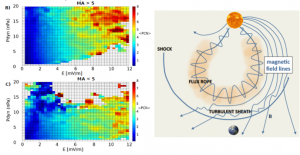Since 1960s we have known that southward interplanetary magnetic fields and fast solar wind are behind every significant space weather disturbance. These conditions allow magnetic reconnection opening the dayside magnetopause and transferring effectively solar wind plasma and momentum into the Earth’s magnetosphere.
Stronger and faster solar wind does not however necessarily mean stronger space weather storms. This non-linearity in the response of our near-space environment is known as the saturation of the potential across the polar cap. Many theories have been presented to explain why polar cap potential saturates, but none of them works for all solar wind conditions.
In this paper we just published in Geophysical Research Letters we examine how the saturation depends on solar wind conditions, in particular the solar wind dynamic pressure. We examined three decades of near-Earth solar wind measurements. Our key finding is that the high solar wind dynamic pressure can prevent the polar cap potential from saturating. This means that the largest geospace storms occur when dynamic pressure is high.
But what structures in the solar wind can provide such conditions? The best candidates are the magnetosheaths of coronal mass ejections (CMEs) that are composed of the turbulent plasma compressed at the CME-driven shock waves. From our previous works we indeed know that the sheaths are very efficient drivers of space weather storms and that their couple with the magnetosphere stronger than the CME flux rope itself.
Link to the paper: http://onlinelibrary.wiley.com/doi/10.1002/2017GL072676/abstract
